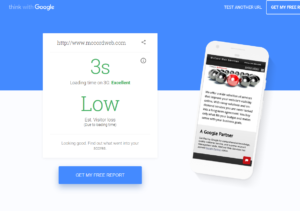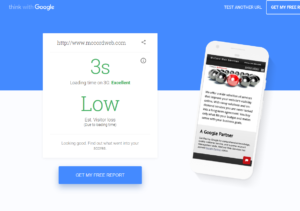
In our new world where over 65% of all Google.com searches are done on smartphones, what happens to a website that is not mobile-friendly in regards to lead conversions, store sales, and organic placement?
The PPC Picture
Google has lots to say on this topic of mobile friendliness. For sites that are not mobile-friendly and the business owner is advertising in Google Ads, Google flags the account with messages such as this:
“Avoid losing customers on mobile devices by improving your mobile site. Recommended because 98.57% of your mobile clicks go to non-mobile-friendly pages on your site. 68.97% of clicks from all devices come from mobile. 98.57% 138 of 140 clicks go to pages that are not mobile-friendly.“
As Google Ads is incredibly focused on relevance and offering the best user experience, I expect in the future ads that are not showing mobile-friendly pages to start to receive very poor quality scores driving up the click cost and reducing exposure due to a low ad rank.
Google has been pretty forthcoming in regards to page speed as well. A 1-second delay in page response can result in a 7% reduction in conversions. For a store generating $60,000 in sales a month, that is a loss of $4,200 in monthly sales. In a year, that translates into $50,400. A non-mobile friendly site is not optimized for speedy download and may be virtually impossible to use on a smartphone driving away potential customers. Many will never come back to visit. This is a very serious impact for Google Ad activity.
For sites that do not have a mobile-friendly website, conversion numbers are dropping in Google Ads. Mobile activity is a very big part of the conversion path now for sales and leads.
WordStream has done a very nice visual on sales, conversions, and cost per conversion in mobile and it is clear that mobile is big business. Without a mobile website you are missing out on a huge sector of growing and converting traffic.
For some websites that are not mobile-friendly using Duda Mobile to do a scripted redirect to a Duda Mobile mini site worked – but no longer. Google Ads is aggressively disapproving ads for our clients that are using this approach and we are now having to remove the code from those websites effectively making them now not mobile-friendly for organic or for pay per click activity.
The Organic Picture
For organic traffic, know that Google now spiders the mobile version of a website and this is the content that now determines your site’s organic ranking on Google.com for all devices, not just mobile.
By not updating your website to be mobile-friendly Marketing and Growth Hacking says you can kiss your Google rankings good bye.
Additionally, Marketing and Growth Hacking states “Based on the blogs Google is putting out, we can confidently assume companies who don’t optimize for mobile will see their rankings disappear. At the same time, companies who adopt and take advantage of mobile-friendly sites early-on have and will continue to see higher rankings.”
I agree that if you mean to be in business, grow sales, and compete effectively, your website and store must be mobile-friendly.
For more information about our services please visit us at www.McCordWeb.com.


